A dual-SIM phone allows you to use two different SIM cards, with two mobile networks and two phone numbers on a single device.
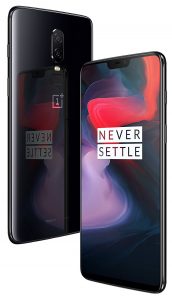 Traditionally, dual-SIM smartphones have been a rarity in the UK mobile market. However, they’ve rapidly grown in popularity over the last few years as an increasing number of people buy unlocked smartphones from manufacturers like Huawei, Motorola and OnePlus.
Traditionally, dual-SIM smartphones have been a rarity in the UK mobile market. However, they’ve rapidly grown in popularity over the last few years as an increasing number of people buy unlocked smartphones from manufacturers like Huawei, Motorola and OnePlus.
Dual-SIM smartphones allow you to use two different SIM cards at the same time on one handset. This means you can be simultaneously connected to two mobile networks on just one device. The advantages range from being able to use a single device for both personal and work usage, to being able to take advantage of greater coverage and lower price on two mobile networks.
In this article, we’ll discuss how you can benefit from a dual-SIM smartphone, and what you should look out for when choosing a dual-SIM device. We’ll then look at how you can buy a dual-SIM smartphone from mobile phone retailers in the UK.
Contents
Using a Dual-SIM Smartphone
 There are three major use cases for a dual-SIM smartphone:
There are three major use cases for a dual-SIM smartphone:
- Use the same mobile phone for personal and work. Often, you’ll have two mobile phone connections: perhaps one for personal usage and another for work usage. Instead of carrying around two separate mobile phones, you can instead use a dual-SIM smartphone which combines the functionality of both.
- Combine the benefits of two different mobile networks. Often, different mobile networks have different benefits. For instance, one mobile network might give better coverage when you live or work, whereas a different mobile network may have lower rates (e.g. for calling in the UK, calling abroad, or more data for the same price). Alternatively, a second SIM card may give you access to exclusive customer offers, such as through O2 Priority.
- Travel abroad and save money with two SIM cards. When travelling abroad outside of Europe, you’ll normally need to pay an extortionate amount for roaming on your mobile phone. With a dual-SIM smartphone, it’s possible to side-step these charges by using a locally-obtained SIM card from the country you’re visiting. You can also have your normal UK SIM card as the second SIM, allowing you to receive calls and text messages on your normal UK number.
Dual-SIM smartphones normally aren’t popular with the mobile networks as they allow you to easily side-step charges from the mobile network (e.g. for travelling abroad or for calling other countries). They also require the handset to be unlocked. For this reason, you’ll normally need to buy your dual-SIM smartphone from an electronics retailer, on a SIM-free and unlocked basis.
Choosing a Dual-SIM Smartphone
When choosing a dual-SIM mobile phone, there are three important considerations worth thinking about:
Dual Standby VS Dual Active
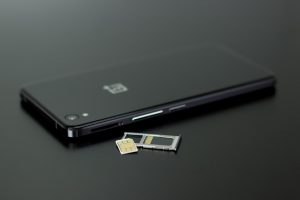
The vast majority of dual-SIM smartphones use “dual-standby technology”. This is sometimes referred to by its full name of dual-SIM dual-standby (or DSDS for short). On a dual-standby mobile phone, it’s only possible to use one SIM card at a given time for making or receiving phone calls. If either SIM card is being used for a call, the other SIM card will be disabled for the duration of the call. For most people, this shouldn’t present too many problems but it’s worth being aware of this limitation.
If you’re a heavy power user wanting to make multiple phone calls at the same time, you’ll instead need to buy a mobile phone with dual-SIM dual-active (DSDA) technology. These phones are much harder to find and are also much more expensive, but have two transceivers so you can be making a phone call on both SIM cards at the same time. You can also do things like putting one call on hold whilst you handle the other call, or you could connect the two phone calls together into one conversation.
Nowadays, it’s incredibly difficult to find a mainstream device that has dual-SIM dual-active technology. If you do require the very specific functionality, it’s likely you’ll need to undergo a detailed search for a more specialist device.
In our opinion, the more mainstream dual-standby devices should suffice for most consumers and are also much more readily available.
Network Types (Dual SIM 4G vs 4G+2G)
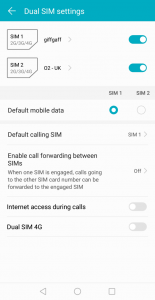
At the time of writing, most dual-SIM smartphones have 4G+2G connectivity. This means you’ll get 4G connectivity on your primary SIM card and 2G connectivity on your secondary SIM card. It’s worth knowing this because you’ll need to make sure the mobile network used on your secondary SIM card slot has support for 2G coverage.
In the UK, most mobile networks still provide some 2G coverage. However, Three is a notable exception in that it doesn’t provide any 2G coverage. Unfortunately, this means you aren’t able to use a SIM card from Three in the secondary SIM card slot, or from any other virtual network operator that uses coverage from Three (this includes iD Mobile, Smarty, Superdrug Mobile and more).
Outside the UK, a number of countries have begun switch off 2G coverage. For instance, 2G coverage is no longer available in countries like Australia, Japan, Singapore and Taiwan. In other countries, it has been partially switched off. For instance, in the United States, AT&T has switched off 2G meaning it’s now only available on T-Mobile. This is worth knowing as it might affect you when travelling to other countries with a dual-SIM device.
On some newer devices, you’ll find support for 4G+4G (Dual SIM 4G) connectivity, or sometimes 4G+3G connectivity. The benefit of this is you’ll be able to access a wider range of connectivity on both SIM card slots, including mobile networks that lack 2G support. In our opinion, a device like the Honor View 10 is worth considering if you’d like Dual SIM 4G connectivity.
SIM Card Slot Design

Finally, it’s worth taking a look at the design of the SIM card slot.
On dual-SIM phones, there will typically be a SIM card tray where you’re able to insert a SIM card from each provider (typically, this will be either two micro-SIMs or two nano-SIMs).
In some cases, the SIM card slot is designed in such a way where the slot for your secondary SIM card doubles up as the slot for your micro-SD card. This is unfortunate as it means you’ll need to make the choice between having dual-SIM connectivity and additional micro-SD storage. Whilst there are some hacks to get around this (e.g. fusing part of the secondary SIM card onto the back of your micro-SD card), these hacks are often dangerous and are not recommended.
Where possible, we’d recommend choosing a handset that has separate physical slots for the secondary SIM card and micro-SD card.
Buying a Dual-SIM Smartphone
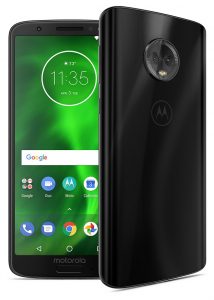 If you’d like to buy a dual-SIM smartphone, you’ll typically need to buy it on an unlocked basis from an electronics retailer. It typically isn’t possible to buy it on contract from a mobile network (dual-SIM smartphones tend to be unpopular with them, as they make it easier for you to bypass charges e.g. for international calling and roaming).
If you’d like to buy a dual-SIM smartphone, you’ll typically need to buy it on an unlocked basis from an electronics retailer. It typically isn’t possible to buy it on contract from a mobile network (dual-SIM smartphones tend to be unpopular with them, as they make it easier for you to bypass charges e.g. for international calling and roaming).
When choosing a dual-SIM smartphone, look out for other related features that can make your life easier. For instance, Motorola has a featured called intelligent calling which will automatically choose the best SIM card when you place a call. Similarly, Huawei has a feature called App Twin which allows you to run two separate instances of a single application (e.g. you could have separate WhatsApp accounts for your personal and work phone numbers).

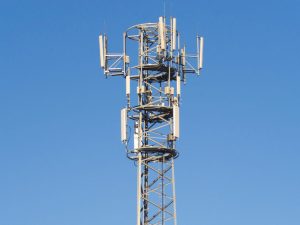



Barneygoogle said:
Hi, Is the Motorola G9 Play (from John Lewis, currently at £159.95) a dual sim?
K4C said:
Hi. If I buy a phone on a contract from ID or EE for instance, I be able to use the dual sim function of the phone? Can I put in both the EE sim and another SIM (from another country) inside the phoen? Would the fact that it is on contract prevent this?
Ken replied:
Hi K4C,
Thanks for your comment. Yes, you an use a contract SIM card inside a dual-SIM smartphone without any issues. There may, however, be an issue with your iD Mobile SIM card if you’re using it as a secondary SIM card in a device where the second SIM slot only supports 2G. This is because iD Mobile doesn’t provide any 2G coverage. If you’re using a Dual SIM 4G handset, both an EE and iD Mobile SIM card should work without issues.
Hope this helps,
Ken
Lory said:
I have bought a dual sim I phone but apparently Vodafone do not support dual sim. My other sim is three is this true.
Ken replied:
Hi Lory,
Thanks for your comment. There’s no problem using a Vodafone SIM card in a dual-SIM phone. However, a SIM card from Three will not function in many dual-SIM phones, if the secondary SIM card is restricted to 2G coverage only (as Three do not offer any 2G coverage).
Ken
Dennis said:
If my phone has two slots for sim card and one for micro SD card but one of the sim card slots is blocked what do I do to be able to have both Sims and an SD card at the some time?
Ken replied:
Hi Dennis,
Thanks for your comment. Does the second SIM card slot on your mobile phone double up as the micro-SD card slot? If so, it unfortunately won’t be possible to use the dual-SIM functionality at the same time as using Micro SD. The only workaround I’m aware of requires some DIY engineering as described on this page but I personally wouldn’t recommend this as it’s possible you’ll damage your SIM card or SD card (in some cases, you can also damage your handset by doing this).
Ken
Mike said:
Can i use my standard sized sim in a dual phone
Ken replied:
Hi Mike,
Thanks for your comment. It depends on the size of SIM card that is accepted by your dual-SIM phone! Some dual-SIM phones use 2 standard SIMs, but they might equally use 2 Micro SIMs or 2 Nano SIMs.
Ken
Norman said:
Hi can you tell me which phones are dual active thanks
Ken replied:
Hi Norman,
Sadly, I don’t think there are very many dual active phones out there any more! Is there a reason you need a dual active phone rather than dual passive? With the increase in voice-over-IP calling, I think it’s now less necessary to have a dual-active device.
Ken
Roy Powell said:
Hi Ken, I have purchased a Ruggex dual sim flip phone. One sim is working on3g the other is working on 2g. Bother sims are from Vodafone. I am using them on Pay as you go. My question is do I have to do top ups for each individual SIM card. You advice would be much appreciated. Very best wishes, Roy.
Ken replied:
Hi Roy,
Thanks for your comment. Yes, you’ll need to top-up the two SIM cards independently. As far as Vodafone are concerned, the SIM cards could be in two totally different devices!
Ken
roy.powell replied:
Thank you for the info, I thought that would be case. The first sim is working on 3G second sim is working on 2g at least that is saying it is on home screen at times it seems a little hesitant so I won’t bother with that one. Again thank you very much for the swift reply. Very best wishes, Roy
PSB said:
As far as I can tell, the second sim on a dual sim phone has to be 2G but none of the network providers supply 2G sim cards – how does this work?
Ken replied:
Hi PSB,
Thanks for your comment. The SIM cards you get today from your mobile network will normally be provisioned to work on 4G or 5G. However, they remain fully backwards compatible so you can still access 2G or 3G, providing there’s coverage available. At present, most UK networks still offer some 2G coverage (with the exception of Three and all other mobile networks using coverage from Three).
Hope this helps,
Ken
Richard said:
Hello Ken,
First of all I should have written Moto G6, not G9!
Things get more mysterious!
I ‘phoned EE technical support and they say that 2G should be available in my area! After trying several monitoring apps I managed to discover that EE 4G is on 1800 Mhz and 3G on 2100 MHz. With O2 2G is on 900 MHz, 3G also on 900 MHz and 4G on 800 MHz. According to Wikipedia EE 2G is only ever on 1800 MHz.
Three possibilities I can think of:-
1. EE are keeping what 2G is left (they have been converting some 1800 MHz spectrum from 2G to 4G, I read) for old non-smart phones.
2. Moto G6 ‘phones can’t switch from 4G to 2G on 1800 MHZ.
3. My particular ‘phone is faulty.
Note that I can switch from 2G to 3G on 900 MHz. My bet is that 1. is the explanation.
Thanks,
Richard
Ken replied:
Hi Richard,
Thanks for getting back to me! It’s true that EE have been converting (or “re-farming”) some of their 1800MHz spectrum from 2G to 4G. However, there should still be an active 2G service and I don’t believe this will discriminate based on the device you’re using. I don’t believe they’d be allowed to do this as mobile networks are supposed to be impartial to what device you’re using.
Could one possibility be that you’re living in an EE 2G coverage blackspot? Nowadays, it’s very much possible for 4G to give better coverage than 2G, as it can use lower-frequency spectrum (e.g. 800MHz) that will travel further than 2G. I believe EE have also been consolidating & reducing their 2G masts since the original merger of the Orange and T-Mobile networks.
Ken
Ken
Richard replied:
Hi Ken,
Thanks again for the extra insight. I don’t think it’s a 2G blackspot. It looks as if my EE 4G is on 1800 MHz (according to the app I used) which is the same frequency as the 2G I can’t get since according to Wikipedia *all* the EE 2G is on 1800 MHz. What’s more I was out today in town (2 miles away) where the signal is very good (excellent according to the app I used), 4G still on 1800 MHz. and still no 2G on offer.
There is I suppose a possibility that the Moto G6 radio is not capable of being switched from 1800 MHz 4G to 1800 MHz 2G without a reset of some kind and that if 4G is available 2G just won’t be offered. I checked the Motorola spec. and GSM B3(1800) is in the spec.
Mind you the O2 SIM I have is happy with 2G 900 MHz, 3G 900 MHz, and 4G 800 MHz so it can switch between 3G and 2G with both on 900 MHz.
All in all a bit of a mystery – perhaps I’ll call EE support again though I’ve decided I’ll probably switch to O2 anyway since the signal is so much better here and I don’t care much about download speed (O2 4G is faster than my WiFi anyway) – must get a PAC soon.
Ken replied:
Hi Richard,
That’s really bizarre. I’m afraid I really don’t know why that’s happening! Do please let me know if you ever get to the bottom of it, as I’d love to understand why it isn’t working as well.
Ken
Richard replied:
Hi Ken,
I asked the question on the Lenovo-Motorola forum and have just had a reply from a Motorola person:-
https://forums.lenovo.com/t5/Moto-G6-Moto-G6-Plus-Moto-G6/No-2G-coverage-on-EE-monthly-SIM-in-UK/m-p/4469318#M13540
… So it looks as if Motorola and EE together are essentially saying that I’ll get either 2G or 3G but even if both are available the choice is down to them not me!
Richard said:
I have a dual SIM Moto G9. As far as I can tell it offers 3G on both slots with 4G on one slot and 2G on the other. The slot you choose for data seems to be 4G and the non-data slot is 2G. Does that sound plausible? It seems logical.
Things are a little complicated here. I have a PAYG 3-2-1 O2 SIM and an EE PAYG (monthly) SIM. It seems that there is no EE 2G coverage here since whatever I do I can’t get the phone to display 2G using the EE SIM (even on it’s own). If I set the O2 SIM for data, O2 offers 4G, 3G and 2G while the EE one only offers 3G Perhaps that is expected too …. If I set the EE slot for data, EE offers 4G and 3G while O2 offers 3G and 2G – probably tht’s expected too.
Ken replied:
Hi Richard,
Thanks for your comment. Yes – that sounds spot on. With most dual-SIM smartphones (but not all), 3G & 4G is only supported on one SIM card at a time. The idea is you’ll only be able to use one SIM card at a time for mobile data (which requires the higher speeds) and that it’s pointless for the second SIM card slot to support 3G or 4G (as it would make little difference for calling and texting).
In reality, however, like you said, 2G coverage isn’t always available depending on your mobile network and where you live. In these situations, it’s definitely useful to have 3G or 4G support on the second SIM card slot (and unfortunately, you’ll need to read the handset specifications very carefully to see which type of dual-SIM support the handset really has). Besides changing to a handset that supports 3G or 4G on the second SIM card slot, the only thing I can really suggest is changing to a mobile network that gives 2G coverage in your area.
Sorry I couldn’t be more helpful!
Ken
Colin said:
Why does the Mi9 dual sim feature not work in the UK?
Ken replied:
Hi Colin,
Thanks for your comment. Can you shed any more light on the reasons this feature doesn’t work in the UK? I’ve had a quick look online and it appears this functionality should work fine in the UK (e.g. Clove is a UK retailer advertising the dual-SIM option on this phone).
Ken